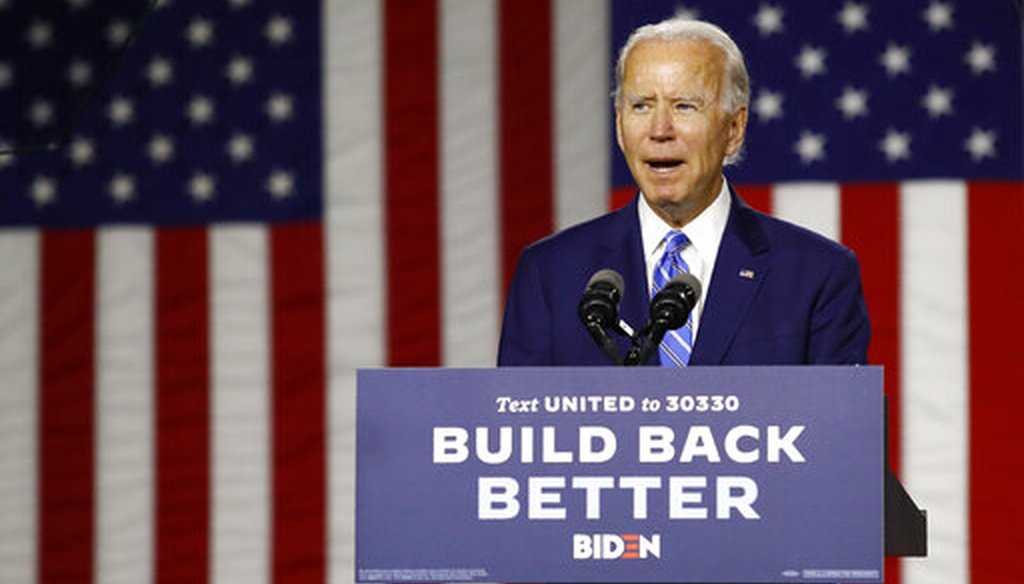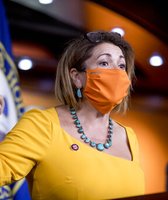Stand up for the facts!
Our only agenda is to publish the truth so you can be an informed participant in democracy.
We need your help.
I would like to contribute

Democratic presidential candidate, former Vice President Joe Biden speaks during a campaign event, Tuesday, July 14, 2020, in Wilmington, Del. (AP Photo)
If Your Time is short
-
Joe Biden is linking economic recovery from the coronavirus pandemic to addressing climate change.
-
The plan’s big goals are to eradicate carbon pollution from the power sector by 2035 and to achieve net-zero emissions by 2050.
-
Biden’s new climate plan has some key differences from his original plan. For one, it’s more pricey.
Joe Biden, the expected challenger to President Donald Trump, says he can lead the United States to recover from the economic challenges brought on by the COVID-19 pandemic. He also says he can lead in the fight against climate change. In fact, the former vice president believes those two efforts should go together.
"Here we are now with an economy in crisis but with an incredible opportunity not just to build back to where we were before, but better, stronger, more resilient," Biden said in a July 14 speech in Wilmington, Del.
Those words echo Biden’s overarching economic recovery plan, which includes his new climate plan. Biden’s campaign rolled out the Build Back Better agenda recently to address economic recovery for small businesses and families.
The new $2 trillion climate plan sets a target for achieving net-zero emissions by 2050, which would balance out the emission and removal of greenhouse gases that warm the planet. His plan would make the electricity sector free of carbon pollution by 2035; make all new U.S.-made buses zero-emissions by 2030; set a goal for disadvantaged communities to receive 40% of benefits from "clean energy" and infrastructure spending; and create a net-zero emissions standard for all new commercial buildings by 2030.
Biden is aiming to move toward a less carbon-intensive economy by creating millions of jobs to help reshape the country’s energy, transportation and infrastructure sectors, with workers being able to join unions and collectively bargain.
Sign up for PolitiFact texts
Trump criticized Biden’s climate policy in a White House Rose Garden speech July 14. "Joe Biden gave a speech in which he said that the core of his economic agenda is a hard-left crusade against American energy," Trump said.
Many climate advocacy groups say this plan is an improvement from Biden’s original climate plan released in June 2019. They like that it speeds up the timetable for cutting emissions. However, other climate change groups and experts have wide-ranging concerns, because the plan doesn’t include a carbon tax or move quickly enough to keep fossil fuels in the ground.
Samantha Gross, director of the Energy Security and Climate Initiative at the Brookings Institution, said Biden’s plan is "ambitious but possible."
"In order to get this done, it depends tremendously on what happens with the congressional elections as well," Gross said.
Energy
Biden’s proposal calls for adding more jobs for construction workers, scientists and engineers to build electricity-producing sources from wind and solar. The plan would create an Energy Efficiency and Clean Electricity Standard for utilities and grid operators.
Biden would also continue generation from nuclear and hydropower. The plan states that his administration would create a climate research agency that works to make nuclear reactors safer and more efficient.
Wind and solar made up 9% of large-scale electricity generation in the U.S. in 2019, the Energy Information Administration estimated. Nuclear power made up nearly 20%, and hydropower made up less than 7%.
The new climate plan proposes advancing research in carbon capture and storage technology, which prevents carbon dioxide from entering the atmosphere.
Infrastructure
Biden’s new climate plan proposes creating millions of union jobs to make transporting goods and people via roads and bridges, rail, aviation, ports, and inland waterways faster and less expensive. Biden also wants to make infrastructure more resilient to disasters exacerbated by a changing climate.
"Biden will also transform the energy sources that power the transportation sector, making it easier for mobility to be powered by electricity and clean fuels," the plan says.
The plan states that Biden’s infrastructure investments will address disparities in accessing clean air and water, transportation, high-speed internet, jobs, and educational opportunities. That would include making investments to replace lead pipes, for example.
In an effort to reduce emissions, Biden is setting a goal to provide "quality public transportation" to Americans in cities with over 100,000 people by 2030. The Biden campaign proposes creating a program that allocates resources to build public transit options in cities.
How does this plan compare with Biden’s original plan?
One difference between Biden’s original climate plan and his new one is the cost. The original plan would have invested $1.7 trillion over 10 years, while this plan proposes spending $300 billion more than that over a shorter period of time.
"All of those are sort of estimates that require a ton of assumptions, and the estimates are only as good as the assumptions you put in," Gross said.
Biden plans to pay for this by raising the corporate income tax rate, increasing taxes on wealthy Americans and using stimulus money.
The original plan did not include the goal to achieve a carbon-free pollution power sector by 2035. In addition, the new plan includes a proposal to create an Environmental and Climate Justice Division within the Justice Department. That idea was previously proposed by Democratic Washington Gov. Jay Inslee, who made climate change central to his presidential bid. Inslee supports Biden’s new approach.
"It is a go to the moon project to get people to work," Inslee said July 14 on MSNBC’s "Andrea Mitchell Reports." "This would have been a good plan a year ago. It’s a great plan now, because it answers the needs of the moment."
What experts and activists say about Biden’s climate plan
For all the proposals Biden wants to implement to fight climate change, some climate activists say his plan doesn’t go far enough to reduce carbon emissions and protect Indigenous lands from fossil fuel pollution.
The plan’s focus on carbon capture and removal technology is one of the "false solutions" throughout Biden’s agenda, said Tom Goldtooth, executive director of the Indigenous Environmental Network. The network calls for the U.S. and Canada to keep 80% of known fossil fuel reserves in the ground, which would reduce contamination on Indigenous lands.
Fossil fuels made up 63% of large-scale electricity generation in the U.S. in 2019, according to the Energy Information Administration.
Bob Inglis, executive director of republicEn, a conservative climate policy group, said he would like to see Biden’s climate strategy implement a carbon tax that is border adjustable and revenue neutral, meaning there would be a fee on imports from countries without a carbon tax and the U.S. government would not keep money from the tax.
"It’s the most powerful step toward a worldwide solution to climate change," said Inglis, who previously represented South Carolina’s 4th District in the House. He added that including a fee on imports would "get other countries to join us in fixing the economics of free dumping into the trash dump of the sky."
The Sunrise Movement, which supported Vermont Sen. Bernie Sanders in the Democratic primary, in April called on Biden to adopt the frameworks of the Green New Deal. When Biden released the new plan July 14, the group tweeted its support.
"Our movement made this possible, but there’s more work to do, and the urgency of the crisis demands that we keep pushing," the statement said.
Inglis said aiming to achieve net-zero emissions by 2050 is an ambitious but important target.
"It’s as realistic as it was for JFK to say we’re going to the moon," Inglis said.
Our Sources
Joe Biden for President, The Biden Plan to Build a Modern, Sustainable Infrastructure and an Equitable Clean Energy Future, accessed July 20, 2020
C-SPAN, Joe Biden Remarks on Energy Policy in Wilmington, Delaware, July 14, 2020
Joe Biden for President, Joe’s Plan for a Clean Energy Revolution and Environmental Justice, accessed July 21, 2020
Joe Biden for President, Build Back Better: Joe Biden’s Jobs and Economic Recovery Plan for Working Families, accessed July 21, 2020
Phone interview with Matt Hill, deputy national press secretary, July 21, 2020
Phone interview with Benjamin Zycher, American Enterprise Institute, July 21, 2020
Sunrise Movement tweet on July 14, 2020
Phone interview with Tom Goldtooth, executive director of the Indigenous Environmental Network, July 22, 2020
The White House, Remarks by President Trump in Press Conference, July 14, 2020
World Resources Institute, What Does "Net-Zero Emissions" Mean? 6 Common Questions, Answered, Sept. 17, 2019
The New York Times, Biden Announces $2 Trillion Climate Plan, July 14, 2020
PolitiFact, Approved, but legal hurdles remain, July 15, 2020
Phone interview with Bob Inglis, executive director of republicEn, July 22, 2020
Phone interview with Samantha Gross, director of the Energy Security and Climate Initiative at the Brookings Institution, July 22, 2020
Energy Information Administration, What is U.S. electricity generation by energy source?, February 27, 2020
































